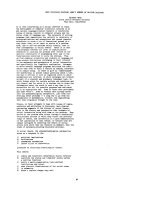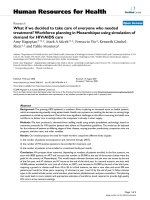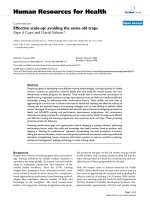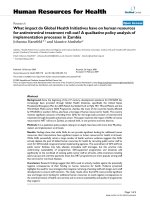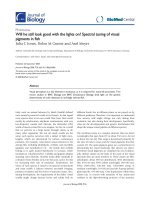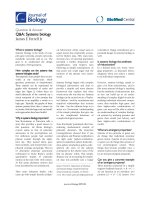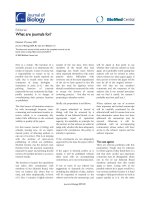Báo cáo sinh học: "What we still don’t know about AIDS" doc
Bạn đang xem bản rút gọn của tài liệu. Xem và tải ngay bản đầy đủ của tài liệu tại đây (159.93 KB, 1 trang )
Robertson: Journal of Biology 2009, 8:87
A great deal is known about the human immunodeficiency
virus (HIV) that causes acquired immune deficiency
syndrome (AIDS) [1], one of whose cardinal features is its
exquisite adaptation to its human host. It enters the body
through damaged epithelia, or more insidiously, through
specialized cells (M cells) in the intestinal epithelium whose
function is to deliver viruses and bacteria to waiting immune
cells in the tissue below. There, the virus binds to a
specialized receptor on the surface of one of these cells – the
dendritic cells, which play a central part in activating the
CD4
+
T lymphocytes whose destruction by the virus
ultimately and lethally disables the immune system.
Recognition of the bound virus causes the dendritic cell to
migrate to the lymphoid tissues where it engages with the
CD4
+
T lymphocytes that it activates. This enables the virus
to bind to molecules on the surface of the T cell – a highly
specific interaction involving the CD4 molecules that give
CD4
+
T cells their name and that enables the virus to enter
the cell. Once the virus is inside the cell, it produces DNA
copies of its genome that integrate into the host DNA where
cellular transcriptional regulators specifically induced by
activation of CD4
+
T cells are instrumental in activating
transcription of the viral genome to produce more viruses.
A great deal is unknown about what happens to the
adaptive immune system in consequence of this fiendish
and focused assault. The adaptive immune system consists
of the lymphocytes that provide lasting immunity, and
CD4
+
T lymphocytes are essential to activating most of
adaptive immunity. The loss of these cells in HIV infection
thus punches an enormous hole in the immune defences of
the host. But CD4
+
T cells are homeostatically self-
renewing, and it is still unclear exactly why they are
progressively lost in HIV infection. It is also unclear what
happens to the dynamics of the immune system. HIV
infection, paradoxically, is characterized by generalized
immune activation the basis for which is not understood.
These lacunae in understanding are due at least partly to
limitations to the research tools available to investigate
these phenomena.
Because of its intimate and specific dependence on the host
cell machinery, HIV infects only humans, although there is a
monkey counterpart, SIV, that produces a syndrome similar
to AIDS in rhesus macaques. (Rhesus macaques are not the
natural host of SIV: in sooty mangabeys, which are, it causes
little inconvenience – another phenomenon that is not
understood.) So AIDS can be investigated only in humans
and monkeys, which are cumbersome and limited
experimental tools. Mice, whose immune systems are the
best-understood in the animal kingdom and which offer
ease of maintenance and manipulation, have no equivalent
pathogen.
With this in mind, George Kassiotis and colleagues set out to
generate a mouse in which, as in human HIV infection,
CD4
+
T cells are killed on activation. They did this by a feat
of genetic engineering involving Cre-lox and the A fragment
of diphtheria toxin (DTA) and which is described both in
their paper in this issue of Journal of Biology [2] and, more
succinctly, in the accompanying commentary [3].
Investigation of the engineered mouse has led them to the
conclusion that at least some of the disturbance to immune
dynamics in HIV infection may be due to the preferential
destruction of a highly topical and much-invoked subset of
CD4
+
T cells called regulatory T cells. In the accompanying
commentary, Nienke Vrisekoop, Judith Mandl and Ronald
Germain explain what is known and what is not known
about immune dynamics in HIV infection, where the mouse
results are and are not consistent with what we know, and
what the value of this tool may be.
One way or another, the CD4
+
T cell conditional mutant
mouse may help to close the gap between the detailed
understanding of the molecular and cell biology of HIV
infection, and the very imperfect understanding of the
impact of HIV on T cell dynamics.
Miranda Robertson, Editor
References
1. DeFranco AL, Locksley RM, Robertson M: Immunity: The
immune response in infectious and inflammatory disease.
London: New Science Press; 2007, 252-257 and 326-327.
2. Marques R, Williams A, Eksmond U, Wullaert A, Killeen N,
Pasparakis M, Kioussis D, Kassiotis G: Generalized immune
activation as a direct result of activated CD4
+
T cell killing.
J Biol 2009, 8:93.
3. Vrisekoop N, Mandl JN, Germain RN: Life and death as a T
lymphocyte: from immune protection to HIV pathogenesis.
J Biol 2009, 8:91.
Published: 27 November 2009
doi:10.1186/jbiol200
© 2009 BioMed Central Ltd
Editorial
What we still don’t know about AIDS
Miranda Robertson
